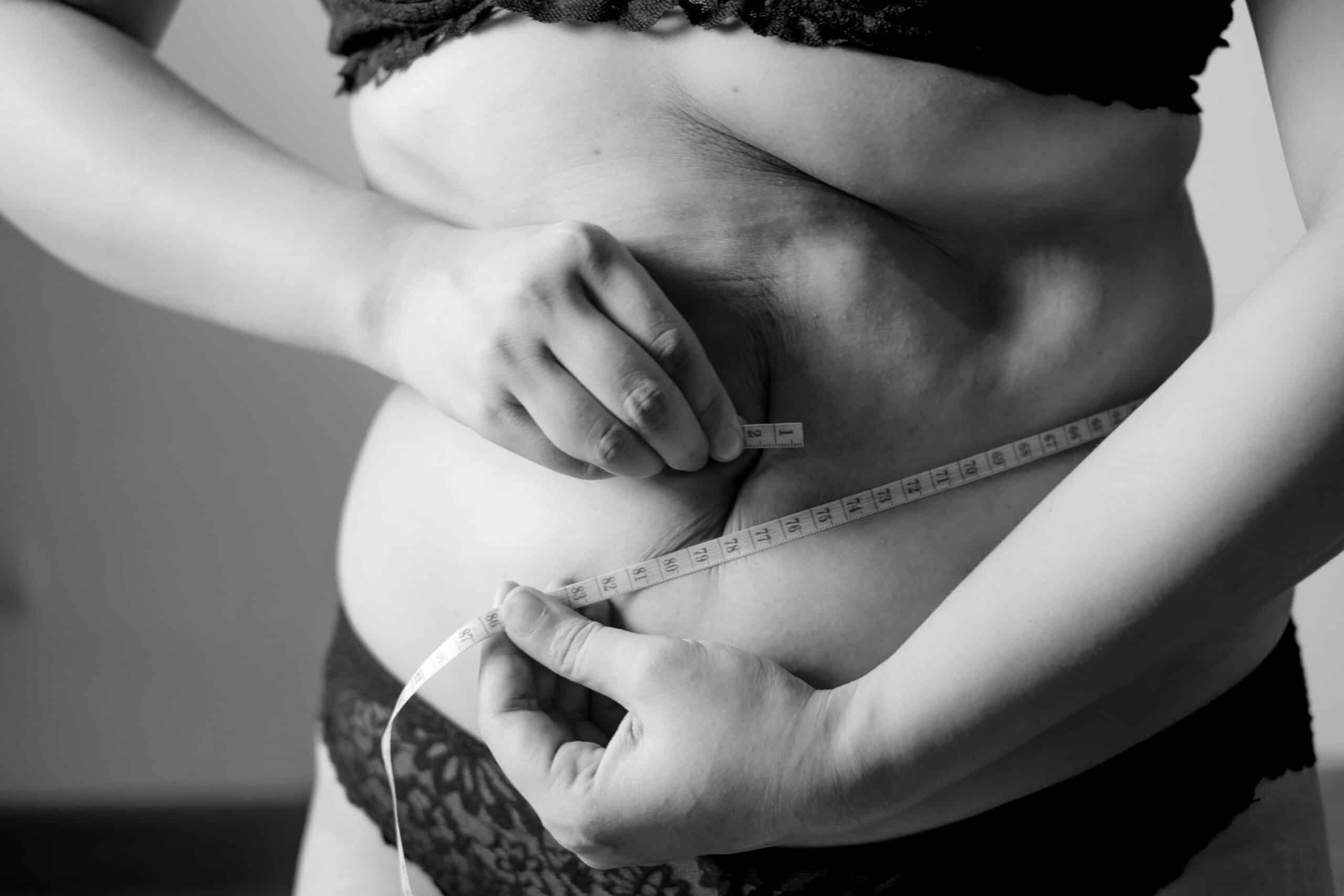and How to Lose This Type of Fat Fast
by: Alexis Martinez

Did you know that our bodies, specifically our bellies, contain two types of belly fat? Understanding the difference between the two will not only help you slim your waistline but also drastically reduce your risk of developing certain metabolic disorders and chronic diseases. In this article, I will share with you what the two types of belly fat are, which of these two types of fat is the WORST type of belly fat.
Sound interesting? If so, keep reading…
Types of Belly Fat:
The two types of fat in our bodies are subcutaneous and visceral fat.
Subcutaneous fat is stored directly under the skin layer and can be found all over our bodies. Someone who has a visibly jiggly belly or body fat that can easily be pinched or grabbed likely has high amounts of subcutaneous fat. Visceral fat, on the other hand, is primarily stored deep within the abdomen. Think of a “beer gut” and how hard and round it is.
Bellies that bulge and are hard to the touch likely contain excess visceral fat.
Keep in mind that both types of fat are necessary for our bodies to function properly. Subcutaneous fat protects and insulates our bodies, while visceral fat protects our vital organs.
However, excess amounts of both types can be detrimental, with visceral fat being the one that can have the worst impact on our health, making it the worst type of belly fat. Let’s explore why.
The main function of visceral fat is to serve as an energy reserve and provide protection for our vital organs. Unfortunately, excess amounts of this fat are linked to metabolic disorders such as glucose intolerance and hypertension, as well as chronic diseases such as heart disease, cancer, and even dementia.
The Major Causes:
Some causes are out of our control. For example, women tend to develop more visceral fat as a result of changes due to aging, such as menopause. Body composition and genetics also play a role.
People who tend to have an apple body shape vs a pear shape tend to have higher amounts of visceral fat because of how their bodies store fat. Despite these uncontrollable factors, the main causes of excess body fat, both visceral and subcutaneous, are controllable.
These Causes Include:
- Overconsumption of calories/Lack of exercise
- Increased Cortisol (stress hormone)
- Lack of sleep
- Excess alcohol intake
Waist-to-Hip Ratio:
So how do you know if you suffer from excess visceral fat? For the most accurate measurement, you would need to have an MRI or CT scan done by your physician.
However, those methods are not easily accessible and can be costly. The best at-home method to get an idea of how much visceral fat your body has is to calculate your waist-to-hip ratio. This calculation takes just 3 simple steps.
- Measure your waist at the smallest point (usually right above the belly button.)
- Measure your hips/buttocks at the widest point.
- Divide your waist measurement by your hip measurement.
For women, a ratio is less than .80 is healthy, while anything above.85 is high. The higher the ratio, the higher your risk is for chronic disease.
Key Steps to Lose the Fat:
So what next? What if you believe you may be at risk for excess levels of visceral fat? Are you doomed? Is a bloated tummy and chronic disease your fate???
Absolutely not! There is hope if you are willing to do a little bit of work. The good news? Although visceral fat is the worst type of belly fat it serves as a quick source of energy ready to be burned and used for fuel, making it easier to burn than subcutaneous fat. By following these next steps, you can quickly lose visceral fat and reduce your risk of everything associated with it.
As an added bonus, you can use these steps to also target stubborn subcutaneous fat, making your results two-fold.
Here are the steps:
- Limit sedentary behavior to 4-7 hours per day. You can do this simply by standing instead of sitting, parking further away from your destination, or adding 10 minutes of light movement to your schedule every hour such as short walking breaks.
- Exercise moderately at least 2-3 days per week for 30 minutes per day. This includes things like brisk walking, chores around the house, dancing, or mowing the lawn.
- Include at least 20 minutes of vigorous or high-intensity interval training (HIIT) at least 3-4 days per week. (HIIT) is particularly important for targeting visceral fat, so be sure not to skip this part. Any moderate exercise can turn into vigorous exercise by increasing the effort. Some exercises include running or sprinting, swimming, circuits, and aerobics. (More great tips can be found HERE.)
- Improve your diet. You can do this by minimizing simple carbohydrates (sugars) like cakes, cookies, or refined, processed grains like white flour, white bread, or pastries. An example of an ideal diet is the Mediterranean Diet. This diet consists of fruits and vegetables, whole grains, healthy oils, and seafood. It also includes moderate amounts of lean meat, such as eggs or poultry, and very limited amounts of red meat. You should limit alcohol intake to moderate levels or less. For women this is up to 1 drink per day.
- Last but not least, get your rest! Lack of sleep causes stress on the body, which is a major contributor to visceral fat storage. The amount of sleep we need is different for each person, but at a minimum, adults should aim for anywhere between 6-8 hours of sleep.
The bottom line…
Visceral fat AND subcutaneous fat are both contributors to the size of our gut. However, visceral fat is the worst type of belly fat.
Even though visceral fat is much more detrimental to our health, it is much easier to lose with the right combination of diet and exercise. By losing visceral fat, you reduce your risk of many chronic diseases, trim inches from your waistline, improve hormone levels, and improve your overall quality of life.

I hold an undergraduate degree in Nutrition and Dietetics, and am currently pursuing my masters degree in Positive Psychology. I am also member of The Academy of Nutrition and Dietetics so I can stay up to date on all the latest nutrition news and research. I am dedicated to sharing what I have and am learning both personally and professionally with women seeking to lose weight and improve their lifestyles.

I hold an undergraduate degree in Nutrition and Dietetics, and am currently pursuing my masters degree in Positive Psychology. I am also member of The Academy of Nutrition and Dietetics so I can stay up to date on all the latest nutrition news and research. I am dedicated to sharing what I have and am learning both personally and professionally with women seeking to lose weight and improve their lifestyles.
